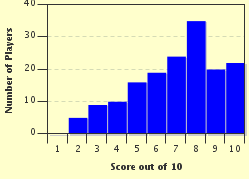Quiz Answer Key and Fun Facts
1. The eldest son of Pepin the Short, I was crowned the first medieval Emperor in the West on December 25th, 800 A.D. Some call me "Pater Europa", "the father of Europe", as I united much of Western and Central Europe under the Carolingian Empire. I am the father of both the French and the German monarchies.
2. As Duke of Normandy, I conquered England in 1066, after defeating the forces of Harold Godwinson at the Battle of Hastings. I was crowned King of England on Christmas Day of that year, in Westminster Abbey. The story of my victory over Harold is depicted in the famous Bayeux Tapestry.
3. I was born Rodrigo Diaz de Vivar, but the Spanish Moors, whom I fought against for most of my life, called me by another name meaning "the Lord". It is by that name that I am better known. I am most famous for my conquest of the Moorish city of Valencia in 1094.
4. A born military leader, I was in command of my own army by the age of 16, and throughout my life I fought in battles and crusades, earning me a regal nickname. Though I was King of England for ten years, I preferred to spend my time in Aquitaine, France, or on the battlefield, fighting to conquer Jerusalem.
5. I received my title, 1st Earl of Pembroke, through marriage, and served four kings of England as a knight and statesman. I was knighted in 1166 and am called by some "the greatest knight that ever lived". I was regent to my fourth king, Henry III, making me one of the most powerful men in Europe at that time.
6. I, Prince of Novgorod, Grand Prince of Kiev and Grand Prince of Vladimir, gained great recognition and status for my military victories against German and Swedish invaders. I was canonized by the Russian Orthodox Church in 1547, and, in 1725, Catherine I created an Imperial Order in my name.
7. I was a Scottish landowner with a brave heart who fought in the Wars of Scottish Independence. I was appointed Guardian of Scotland after defeating the English army at the Battle of Stirling Bridge in September of 1297. In 1305, I was captured and handed over to the King of England, Edward I, on charges of high treason.
8. I was the last Grand Master of the Knights Templar. I was seized in 1307 and subjected to torture before I earned the scorn of King Philip IV of France and was sentenced to burn at the stake for retracting a false confession to alleged crimes committed by the Knights Templar.
9. Never King of England, I was Prince of Wales from 1343-1376, the eldest son of Edward III. Well-known for my military exploits against the French, I became the first Knight of the Garter at age 18. I was also the first Prince of Wales not to succeed to the throne.
10. I was 1st Duke of Suffolk, the life-long friend and loyal subject of Henry VIII of England, and one of the few men of significant power not to be executed during his reign. In 1515 I married Mary Tudor, Henry's sister and the former Queen of France. Forced to act against my personal religious beliefs, I was responsible for the executions of hundreds of men, women, and children to quell the 1536 uprising in Yorkshire known as the Pilgrimage of Grace.
Source: Author
kaddarsgirl
This quiz was reviewed by FunTrivia editor
bloomsby before going online.
Any errors found in FunTrivia content are routinely corrected through our feedback system.


